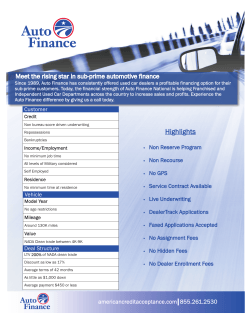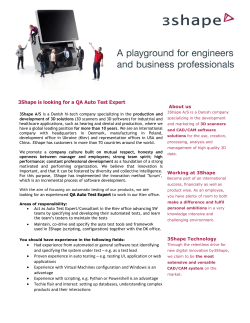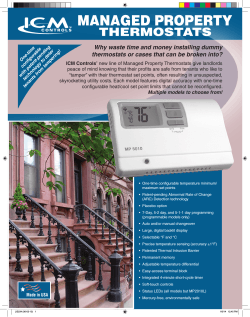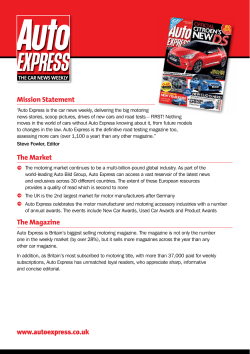
Cadillac president de Nysschen to keynote Auto Show
WANADA Bulletin # 49-14 December 17, 2014 Headlines… Cadillac president de Nysschen to keynote Auto Show Washington reps mark open of 2015 U.S. auto show season in LA Maximize your retirement savings before Dec. 31 Expanded OSHA reporting requirement for workplace injuries Used car depreciation pulls back in November Consumers say they’re wary of spending, but sales are still high AAA finds flaws in driver assistance technologies Drivers interested in autonomous cars, but many want control Thought for the Week… Cadillac president de Nysschen to keynote Auto Show One of today’s most admired automotive leaders, Johan de Nysschen, will present the industry keynote address at the 2015 Washington Auto Show, Thursday, January 22. The address will kick off Public Policy Preview Day at the Walter E. Washington Convention Center. De Nysschen became president of Cadillac in July. As president of the leading American luxury brand of Cadillac, with a history of leadership with several of the world’s top luxury automakers, de Nysschen exemplifies a key thrust of the 2015 Auto Show: The resurgence of the auto industry. “Everyone in this business knows that Johan de Nysschen is someone to watch for his tremendous vision and track record,” said Kevin Reilly, chairman of The Washington Auto Show. “As the Public Policy Show on the global auto show circuit, The Washington Auto Show is proud to present the innovative thinking and can-do spirit that has brought such progress to this critical sector of the American economy.” For 2015, the Auto Show will debut its “Made in America” program, featuring the multitude of jobs and industries supported by the automotive sector. Launching the first of two Public Policy Preview Days, “Made in America” will take place on Wednesday, January 21, with photo ops of various vehicles parked in front of the Capitol building, followed by a series of TED-style talks on the ways that the auto business and the U.S. economy have shaped and supported each other. The WANADA Bulletin is a membership publication published weekly by the Washington Area New Automobile Dealers Association 5301 Wisconsin Avenue, N.W., Suite 210 Washington, DC 20015 Tel: (202) 237-7200 Fax: (202) 237-9090 WANADA Bulletin # 49-14 December 17, 2014 Page 2 The second Public Policy Preview Day will take place at the Walter E. Washington Convention Center and will feature a daylong schedule of press conferences and special events headlined by de Nysschen’s address at the Newsmaker Breakfast, sponsored by the Washington Automotive Press Association and the International Motor Press Association. Johan de Nysschen, 54, was appointed president of Cadillac and General Motors executive vice president on July 11, assuming responsibility for all aspects of Cadillac globally. Cadillac is in the midst of a long-term mission to expand world-wide and elevate its brand into the highest ranks of the extremely competitive luxury auto marketplace. De Nysschen has also spent time as president of Infiniti and Audi. The Auto Show’s Public Policy Preview Days culminate in the popular Sneak Peek Reception, Thursday evening, January 22, for officials in government, industry and media. The show opens to consumers on Friday, January 23, and runs through Sunday, February 1, and is the largest public show in the District of Columbia. Washington Reps mark open of 2015 U.S. auto show season in LA A regular, first up stop on the annual industry auto show tour, Los Angeles is always a grand display, amply bedecked with state-of-the-art vehicles, effusing the latest advanced automotive technology. LA’s 2015 Auto Show was no exception. Automaker executives, media and industry types of all stripe were on hand this year for industry/media days where Washington Auto Show representatives interacted with OEM exhibiter organizers and high level industry operatives. “Like LA, Washington is an OICA accredited auto show, so being in attendance makes sense in order to stay close to the OEM leaders who make the industry shine year after year at major auto shows,” said Kevin Reilly, chairman of The Washington Auto Show. OICA, the Paris based Organisation Internationale des Constucteurs d’ Automobiles, is the worldwide automaker group which accredits tier one auto shows in different countries -- typically one per country , except in the U.S. where five shows are so recognized, reflective of America being the largest new vehicle market. Besides LA and Washington, other OICA auto shows in the U.S. are Detroit, New York and Chicago. Washington Auto Show Committee reps with Michael Bartsch, COO of Infiniti (right); Kevin Reilly, WAS Chairman (center) and Daniel Jobe, WAS Committee (left). WANADA Bulletin # 49-14 December 17, 2014 Page 3 “Besides the opportunity to mix it up with the OEM operatives who make our Auto Show happen, we get a chance to see how the latest new car exhibits are laying out and the sorts of things the media is after as they pour over the displays spotlighting the new model year,” said John O’Donnell, Washington Auto Show producer. “It’s also a chance to preview the latest in auxiliary exhibits that can effectively accent the automaker displays,” he said. Washington Auto Show reps with NADA leaders. Flanking NADA Chairman Forrest McConnell (center) is chairman-elect William Fox (second from right ); John O’Donnell, WAS producer (far right); Kevin Reilly, WAS chairman (second from right); and Barbara Pomerance, WAS communications. Former NHTSA Administrator David Strickland (right),with Gloria Bergquist, Alliance of Auto Manufacturers ; and Kevin Reilly, WAS Chairman With its Public Policy focus, Washington’s Auto Show spotlights the integral connection between the auto industry and Congress, the White House and the federal regulatory agencies which gives industry media days in DC an entirely different direction and flavor. Members of Congress, their staffs, regulatory agency leaders and White House operatives are all front and center at the Washington show, co-mingling with industry leaders and the media. Washington Auto Show industry media days this year are Wed., Jan. 21, 2015 and Thurs., Jan. 22. Public days are Friday Jan. 23 through Sunday, Feb 1. Joining Messrs. Reilly and O’Donnell at the LA Auto Show were Daniel Jobe, Auto Show Committee member, Capitol Cadillac; Barbara Pomerance, Auto Show media & communications; and Bob Yoffe, Auto Show manager. Maximize your retirement savings before Dec. 31 NADART offers a reminder of the 2014 retirement savings limits and encourages dealers to maximize their retirement savings ability before the end of the year. For a 401(k), the maximum allowed contribution amount is $17,500 this year for those under age 50 and $23,000 for older individuals. Those limits will rise to $18,000 and $24,000 in 2015. For an IRA, those under age 50 may contribute up to $5,500; those age 50 or older may contribute $6,500. Those limits will remain the same for 2015. For Social Security, the taxable wage base is $117,000 this year and $118,500 in 2015. Be aware that other circumstances may reduce these limits. Dealers should consult their 401(k) plan representative and/or tax consultant for details that are specific to their situation and plan design. WANADA Bulletin # 49-14 December 17, 2014 Page 4 Expanded OSHA reporting requirement for workplace injuries As of January 1, 2015, the Occupational Safety and Health Administration (OSHA) requires employers to notify it of all work-related deaths, inpatient hospitalizations of any employees, amputations and losses of at least one eye. Previously, employers only had to report work-related deaths and hospitalization of three or more employees. Here are some FAQs: Who must report deaths and severe injuries under the new rules? Most franchised dealers come under OSHA jurisdiction, so dealers should expect to report all qualifying work-related incidents. When should a death be reported? A work-related death must be reported within eight hours of an employer learning of it. Employers only must report deaths that occur within 30 days of a work-related incident. When should a severe injury or illness be reported? Employers must report an inpatient hospitalization, amputation or eye loss within 24 hours after learning of it. They only must report these occurrences if they happen within 24 hours of a workrelated incident. How can I report an event to OSHA? Employers may report events to OSHA by telephone to the nearest OSHA Area Office during business hours, by phone to the 24-hour OSHA hotline at 1-800-321-6742 or (available soon) at www.osha.gov. What type of information must be reported? When reporting a death, inpatient hospitalization, amputation or loss of an eye, an employer must report to OSHA: The establishment name Location of the work-related incident Time of the incident Type of reportable event (such as death or inpatient hospitalization) Number of employees who suffered the event Names of the employees who suffered the event Company contact person and his/her phone number Brief description of the incident. Should employers report inpatient hospitalizations resulting from a heart attack? If the heart attack resulted from a work-related incident, employers must report it. Incidents do not need to be reported if they occur on public streets or highways or on commercial or public transportation. Deaths that occur more than 30 days after the work-related incident or inpatient hospitalizations, amputations or losses of eyes that occur more than 24 hours after the work-related incident need not be reported. Nor do inpatient hospitalizations for diagnostic testing or observation only. Thanks to Michael Charapp, Esq., Charapp & Weiss LLP, for providing this information. WANADA Bulletin # 49-14 December 17, 2014 Page 5 Used car depreciation pulls back in November Used vehicle depreciation saw one of the lowest levels of the year in November, as wholesale prices for vehicles up to eight years old fell by just 1.3 percent, says NADA Used Car Guide. Strong demand for used vehicles and lower auction volume helped end a four-month period with depreciation at or above 3 percent. Auction volume typically falls in November, but this year it dropped more than usual. Volume for vehicles up to eight years old fell by nearly 9 percent, 2 Auction volume fell more than usual in November. percentage points more than last year. Volume for MY 2014 auction vehicles, mostly rentals, fell more sharply than for older vehicles, and that helped alleviate pressure on used vehicle prices. Used vehicle prices are 1.1 percent higher for the year than they were through November 2013. Consumers say they’re wary of spending, but sales are still high Car sales are outpacing other categories of spending. Two recent studies show national consumer spending picking up for the holiday season but consumer morale still shaky as many remain reluctant to spend. Regionally, the effect of new leadership in Congress and a new governor in Maryland, who have both promised to cut spending, is unclear at this point. But consumers in a region still at least partly dependent on government contracts might also become reluctant to spend. Nationally, McKinsey’s latest Consumer Sentiment Survey showed that 40 percent of those surveyed are living paycheck to paycheck. “Americans at all income levels have yet to return to their prerecession positive feelings about the country’s economy,” McKinsey says. Feelings about the economy vary by demographic. Hispanic households tend to be more frugal because of “greater insecurity about personal finances,” the report says. Millennials “are more affected by paycheck cycles and are more involved in money-saving behavior.” Baby boomers are somewhat less likely to cut back on spending. As has been reported previously in the Bulletin, boomers constitute a solid portion of the car market. And low-income consumers are continuing to struggle financially. “Cautious spending behavior is the new normal and is unlikely to change in the near future,” McKinsey concludes. Yet the Commerce Department said last week that November retail sales rose 0.7 percent from October and 5 percent from a year ago. As readers of the Bulletin are well aware, auto sales substantially outpaced other categories. Auto dealers saw the biggest gain of any group, at 1.7 percent. Overall spending for the month was higher than economists had expected. WANADA Bulletin # 49-14 December 17, 2014 Page 6 AAA finds flaws in driver assistance technologies A study by the American Automobile Association has found flaws in blind spot monitoring and lane departure warning systems. Among the problems are delayed warnings by the blind spot monitoring technology and lane departure warning systems that failed to track the lane under certain road conditions. Researchers found that: Blind-spot monitoring systems had difficulty detecting fast moving vehicles, such as those merging onto a busy highway. Alerts were often provided too late to be useful. Worn pavement markers, construction zones and intersections can cause the lane departure warning system to lose track of lane location. Motorcycles were detected by blind spot monitoring systems 26 percent later than passenger vehicles. The alerts and warnings emitted by the systems could be similar to other advanced driver assistance features, causing confusion. “Some blind-spot monitoring systems we tested had short detection range, which meant that a vehicle was already in the blind spot before the alert came on,” says Megan McKernan, manager of automotive engineering at the Automobile Club of Southern California. The lane departure warning system on several vehicles showed false positives and missed some warnings. The driver might elect to disable the system, which is permissible. Drivers interested in autonomous cars, but many want control Eighty percent of vehicle owners are aware of autonomous vehicles, and 29 percent of them would be interested in having one someday, according to a new study by AutoPacific, Inc. They would even be willing to pay upwards of $4,000 for the technology. Relaxation, safety and stress reduction are the top reasons people are interested in autonomous cars. The main reason others are not interested is that they enjoy driving and would prefer to drive themselves. “People who are interested in autonomous vehicles are technology lovers and believe an autonomous vehicle would be safer because the computer can drive more safely than they can,” said George Peterson, president of AutoPacific. But consumers don’t trust the cars completely. More than 40 percent believe drivers should be required to keep their hands on the wheel. Thought for the Week… Christmas is not a time nor a season, but a state of mind. To cherish peace and goodwill, to be plenteous in mercy, is to have the real spirit of Christmas. --Calvin Coolidge WASHINGTON AREA NEW AUTOMOBILE DEALERS ASSOCIATION
© Copyright 2025









